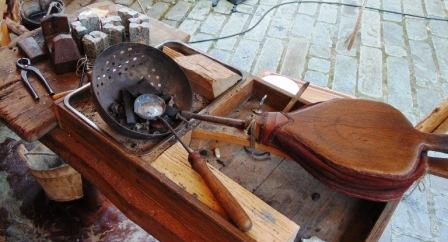A tin containing mineral is cassiterite, which is found mainly in Southeast Asia. Other minerals in low concentrations of tin are: stannite, cylindrite, franckeite, canfieldite, and teallite.
 Tin is one of the earliest discovered metals and was treated with copper, used for the manufacture of bronze. In 3,500 BC. was already known that tin (like arsenic and nickel) had a hardening effect on copper. Therefore it was used in tools and weapons.
Tin is one of the earliest discovered metals and was treated with copper, used for the manufacture of bronze. In 3,500 BC. was already known that tin (like arsenic and nickel) had a hardening effect on copper. Therefore it was used in tools and weapons.
Scientists found in Israel tin that came from Cornwall (England) 3,000 years ago. In the Bronze Age it was essential to make these hard alloys together with copper. Probably there was trade by sea back then.
Even before the Romans there was a flourishing trade between the tin mines in Cornwall and the Mediterranean. The Egyptian pharaoh Pepi has around 2,300 BC. let make a statue that was from tin of these mines.
From around the year 600 tin was also used in pure form.
The earth's crust consists of about 0.001% of tin. Tin is common in Malaysia.
Tin cracks when bent because the crystals break.
The melting point is 232⁰C.
The word tin comes from the Germanic tina for toe or twig that (German Zain) also means "metal rod". The symbol Sn comes from the Neo-Latin stannum or Stagnum for 'alloy of silver and lead.”
Tin attaches easily to iron and is therefore often used as an anticorrosive coating in cans. It is also in organ pipes (lead alloy), in church bells (bronze), as soft solder for electronic circuits and plumbing, cups, (cast) jugs, soldiers, candlesticks.
The salts of tin (II) chloride and tin (IV) chloride are used as a mordant.
Tin is used in the Pilkington process in order to pour glass for windows. Molten glass is poured onto a pool of molten tin. Drives the glass and cools down, whereby solid, flat glass is formed with a flat parallel surface. Most of the glass for windows is produced in this way.
To produce tin the mineral cassiterite (SnO2) is roasted in an oven with carbon.
There are two isotopes of tin. The first is referred to as gray tin and is stable at temperatures below 13.2°C (55.76° F). It has few applications.
At temperatures above 13.2°C gray tin slowly turns into the second form, white tin. Thus, it is mostly used. But it changes again in gray tin as the temperature drops below 13.2°C. This transition is prevented by adding small amounts of antimony or bismuth to white tin.
Tin plate (cans) is rolled thin, against corrosion steel is plated with tin and is widely used as packaging for canned and (soft) drinks.
Marcasite (FeS2) is a compound of sulfur and iron and was used for making sulfuric acid.
